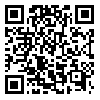Volume 16, Issue 4 (Winter 2022)
Salmand: Iranian Journal of Ageing 2022, 16(4): 550-563 |
Back to browse issues page
Download citation:
BibTeX | RIS | EndNote | Medlars | ProCite | Reference Manager | RefWorks
Send citation to:



BibTeX | RIS | EndNote | Medlars | ProCite | Reference Manager | RefWorks
Send citation to:
Asadi H, Habibi Soola A, Iranpour S. Evaluation of the Relationship Between Frailty and Polypharmacy in the Elderly Referred to the Emergency Departments of Ardabil 2019. Salmand: Iranian Journal of Ageing 2022; 16 (4) :550-563
URL: http://salmandj.uswr.ac.ir/article-1-2108-en.html
URL: http://salmandj.uswr.ac.ir/article-1-2108-en.html
1- Department of Nursing, Faculty of Nursing and Midwifery, Ardabil University of Medical Sciences, Ardabil, Iran.
2- Department of Nursing, Faculty of Nursing and Midwifery, Ardabil University of Medical Sciences, Ardabil, Iran. ,habibiarums@gmail.com
3- Department of Community Medicine, School of Medicine, Ardabil University of Medical Sciences, Ardabil, Iran.
2- Department of Nursing, Faculty of Nursing and Midwifery, Ardabil University of Medical Sciences, Ardabil, Iran. ,
3- Department of Community Medicine, School of Medicine, Ardabil University of Medical Sciences, Ardabil, Iran.
Abstract: (5569 Views)
Objectives: Frailty is characterized by an increased vulnerability to stressors. Frail older patients are at increased risk of Emergency Department (ED) visits, hospitalization, and disability. The aim of this study was to determine the relationship between frailty syndrome and polypharmacy in the elderly referred to the emergency department of Ardabil teaching hospitals.
Methods & Materials: In this cross-sectional descriptive study, 505 elderly people referred to the hospital emergency department were selected by convenience sampling method. Frailty syndrome was measured using the five-item criteria of fried which include: 1) slow walking, 2) muscular weakness, 3) exhaustion, 4) low physical activity and 5) unintentional weight loss. Polypharmacy considered the use of 5 or more drugs. Data were analyzed using descriptive statistics including mean and standard deviation and inferential analysis including analysis of variance, independent t-test, correlation, and multiple regression using spss v. 22 statistical software.
Results: The mean age of participants was 70.91±7.49 and 255 (50.5%) were male, 318 (63%) were married and 271 (53.7%) were illiterate. the results of the study showed that 204 (40.4%) of the elderly who referred to the emergency department had frailty and 177 (35%) had pre frailty. In this population, we identified a 42.2% (n=98) of frail with polypharmacy, 37.1% (n=86) of prefrail with polypharmacy. The correlation test showed that there is a significant relationship between fertility and polypharmacy (P˂0.001). Linear regression analysis showed the variables of age, education, living arrangement, hospitalization, and the number of medications used by the patient as predictors of frailty syndrome in the elderly referred to the emergency department.
Conclusion: Number of drugs used, age, education, living arrangement and number of hospitalizations were predictors of frailty syndrome in the elderly. Considering the living conditions of the elderly and the prevention of unnecessary hospitalizations can reduce polypharmacy and ultimately a preventive strategy to prevent and manage frailty. Of course, further research is needed to confirm the possible benefits of reducing polypharmacy in the development, reversion, or delay of frailty.
Methods & Materials: In this cross-sectional descriptive study, 505 elderly people referred to the hospital emergency department were selected by convenience sampling method. Frailty syndrome was measured using the five-item criteria of fried which include: 1) slow walking, 2) muscular weakness, 3) exhaustion, 4) low physical activity and 5) unintentional weight loss. Polypharmacy considered the use of 5 or more drugs. Data were analyzed using descriptive statistics including mean and standard deviation and inferential analysis including analysis of variance, independent t-test, correlation, and multiple regression using spss v. 22 statistical software.
Results: The mean age of participants was 70.91±7.49 and 255 (50.5%) were male, 318 (63%) were married and 271 (53.7%) were illiterate. the results of the study showed that 204 (40.4%) of the elderly who referred to the emergency department had frailty and 177 (35%) had pre frailty. In this population, we identified a 42.2% (n=98) of frail with polypharmacy, 37.1% (n=86) of prefrail with polypharmacy. The correlation test showed that there is a significant relationship between fertility and polypharmacy (P˂0.001). Linear regression analysis showed the variables of age, education, living arrangement, hospitalization, and the number of medications used by the patient as predictors of frailty syndrome in the elderly referred to the emergency department.
Conclusion: Number of drugs used, age, education, living arrangement and number of hospitalizations were predictors of frailty syndrome in the elderly. Considering the living conditions of the elderly and the prevention of unnecessary hospitalizations can reduce polypharmacy and ultimately a preventive strategy to prevent and manage frailty. Of course, further research is needed to confirm the possible benefits of reducing polypharmacy in the development, reversion, or delay of frailty.
Type of Study: Research |
Subject:
gerontology
Received: 2020/10/04 | Accepted: 2020/11/11 | Published: 2022/01/01
Received: 2020/10/04 | Accepted: 2020/11/11 | Published: 2022/01/01
Send email to the article author
| Rights and permissions | |
 |
This work is licensed under a Creative Commons Attribution-NonCommercial 4.0 International License. |








